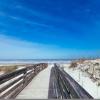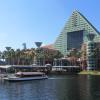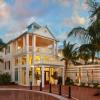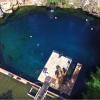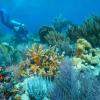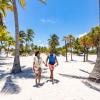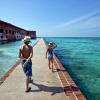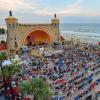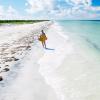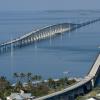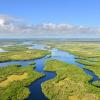St. Augustine's Lightner Museum was once the Hotel Alcazar, commissioned by Henry Flagler.
St. Augustine, Ponte Vedra & The Beaches Visitors & Convention Bureau
Kennedy Space Center Visitor Complex
Contributed photo
By Chelle Koster Walton
A primer on the history of Florida from 10,000 B.C. to the present.
Hop aboard the Florida "way-back" machine to visit rousing eras of wooly mammoths, Native Americans, brave conquistadores, pirates, pioneers, geniuses, millionaires, astronauts and heroes. Here are a few of the most significant historical events in Florida.
10,000-8,000 B.C. -- Move over mastodons and gigantic armadillos. Humans are afoot, heading from what is now Georgia to Florida.
8000 B.C.-1500 A.D. -- Tribes from the Caribbean and Mexico join migrants from the north to settle, fish, trade and worship the sun.
1513 -- He came, he saw ... he left. Juan Ponce de Leon makes the first European landfall somewhere in the vicinity of St. Augustine, claiming La Florida for Spain.
1516-1542 -- More Spanish explorers come to see what all the excitement is about. Ponce de Leon returns, this time to the West Coast where natives greet him with poisoned arrows.
1559 -- He came, he saw ... he tried to stay. Tristan de Luna establishes Florida's first settlement at today's Pensacola Beach. Starvation ensues and de Luna departs.
1564 -- Frenchman Rene de Laudoniere comes, sees ... and stays, some 40 miles northwest of St. Augustine, near the mouth of the St. Johns River in what is now Mayport, at a settlement known as Fort Caroline. This makes the Spanish very nervous.
1565 -- He came, he fought, he stayed. Spain sends Pedro Menendez de Aviles to rid Florida of the French. He establishes the town of St. Augustine, America's first permanent European settlement.
1600-1700 -- Spain is on a mission to "educate" (convert to Catholicism) Florida's native people. Its priests build more than 30 missions along the northeast coast and westward near Tallahassee and St. Marks.
1698-1723 -- Spain sets up camp in Pensacola, which later gets ping-ponged from Spain to France, back to Spain, back to France, back to Spain.
1738 -- Fort Mose, the nation's first black community, is established near St. Augustine in time to defend it against the British.
1763 -- At the end of the Seven Years' War, England gives Cuba to Spain in exchange for St. Augustine, whose citizens pack up for Cuba.
1776-80 -- Florida, now British, supports the Motherland during the American Revolution, providing a safe haven for thousands of Tories.
1783 -- St. Augustine is again swapped, ending up once more in Spanish hands.
1785-1795 -- Spain relinquishes St. Augustine and Pensacola to England.
1803 -- The United States of America claims West Florida and its capital Pensacola as part of the Louisiana Purchase.
1813 -- England is not so keen on giving up Pensacola and Gen. Andrew Jackson arrives to drive the British out.
1818 -- Jackson's actions spark the first of two skirmishes with the Seminole Indians.
1821-1823 -- Jackson becomes Florida's provisional governor when the U.S. purchases Florida and its capital St. Augustine from Spain. Tallahassee becomes the new capital.
1830-1840 -- Boom! Florida's first flush of settlers arrives by steamboat and the population grows from 15,000 to 34,000.
1835-1842 -- Seminole Wars, the sequel.
1845 -- It's official: Florida becomes the 27th state with 66,500 people.
1861-1865 -- It's official: Florida becomes a non-state when it secedes from the Union. Florida provisions Confederate troops with salt, beef and bacon during the Civil War.
1878 -- Tourism dawns at Silver Springs when Hullam Jones glues a window to the bottom of a rowboat and invents the glass-bottom boat.
1883-85 -- Florida gets railroaded. Henry Plant lays tracks on the West Coast, Henry Flagler on the East Coast. Along with the railroads sprout luxury hotels and a new era for Florida travel.
1887 -- Eatonville becomes the first incorporated municipality in America governed by its own African-American population.
1898 -- Florida prepares for the Spanish-American War with forts and army camps.
1904-1912 -- Flagler rides the rails to the end of the line, extending his tracks the 156 miles from Miami to Key West.
1908 -- Jacksonville becomes Florida's Hollywood, where producers make early movies -- years ahead of Hollywood.
1928 -- Transportation makes another forward lurch with the opening of the Tamiami Trail from Tampa to Miami.
1946 -- Jackie Robinson scores a homerun for his people in Daytona Beach as the first African-American to join an all-white team.
1947 -- Score one for Mother Nature: President Harry Truman dedicates Everglades National Park.
1959 -- Fidel Castro's assumption of power results in the first influx of Cuban immigrants to Florida.
1961 -- Transportation looks skyward as Cape Canaveral sends its first manned vessel into space.
1971 -- The mouse is loose. Walt Disney World opens outside Orlando.
1980 -- Nearly 125,000 more Cuban immigrants arrive in the Mariel boatlift.
1982 -- President Ronald Reagan signs the Miccosukee Constitution, making Miccosukee Indian territory independent from the Bureau of Indian Affairs.
1984 -- Florida returns to the rails: Miami debuts its $1 billion Metro rail system.
2000 -- Score one more for Mother Nature: President Bill Clinton authorizes a massive project to restore the fragile eco-system of the Everglades, which have existed and nourished life since the beginning of time in Florida.
PLACES TO REMEMBER
RELATED CONTENT
40 Florida Songs To Add To Your Playlist for the Summer
- 4 minute read
By Sean Daly Our critic was looking not just for themes of sun, surf, sand, and skin, but also mood: mellow, romantic, sweaty and geography, from the...
Visit the Homes of These Famous Authors in Florida
- 6 minute read
By Gary McKechnie Perhaps it is Florida’s diversity that lends itself to an author’s literary expression. Our state is a cauldron of...
Beyond Florida Highwaymen: 5 Florida Artists You Need to Know
- 8 minute read
By Jodi Mailander Farrell From the 1950s to the 1980s, a group of 26 black artists known as the “Florida Highwaymen” painted vivid...

